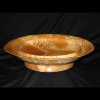Some will say your tools aren't sharp enough, some will say you need to work on your technique, but my experience is that it's never completely avoidable. Wood species, figure and how dry it is will have just as much effect as using a not quite sharp enough gouge. Dry wood will always tear out more than wet. Some softer woods will tear out more than harder, but that's not always the case. Overall, I'd put maple, cherry, sycamore and beech (there's probably a few more) as the lowest in tear out overall. Dry oak, bubbinga and anything with really high figure are at the other end. The first photo is a bowl about 8" in diameter of dry curly chestnut. The outside turned fairly well, but finishing the inside took a lot of 60 and 80 grit sanding. The second, dry hard maple had tear out where the figure reversed itself in several places, but not on the end grain. The third is a 24" bubbinga piece that took me seemingly forever to sand out the inside since it's so hard a wood, has to be dry to get into the US, and is so large.




